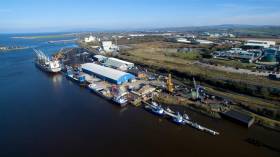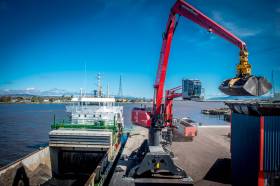Displaying items by tag: Foyleport
Foyle Port Posts Resilient Results Despite Pandemic Challenges
The latest financial results for Foyle Port's financial year ending 31st March 2021 show performance at the port remained ‘resilient' over the past year despite severe challenges posed by the Covid-19 pandemic.
The figures published today show that trade has reduced by 9% to 1.7 million tonnes while the Port’s operating profit reached £1.5 million, reflecting a 12% reduction on the previous year. Turnover was £9.2 million, slightly down on last year’s pre-Covid £10.4 million.
Despite the unprecedented challenges that both the pandemic and the post-Brexit landscape posed to the Port, and the maritime sector more generally, Foyle Port reinvested approximately £1 million in fixed assets, taking the Port’s asset base to £42.7 million.
The north-west Port, which employs 108 people and generates £4.3 million in wages annually, also sources 80% of its electricity from low carbon fuel sources and is continuing to meet its decarbonisation obligations by investing in electric vehicles. Over the last year, the Port has reduced its CO2 emissions by 76 tonnes.
The Port has also supported a number of charities and charitable initiatives over the past 12 months which includes forming a new partnership with leading mental health charity Aware NI, implementing a new Mental Health Policy at the Port. As well to ensuring that 1% of all Port profits go towards the Port’s Corporate Social Responsibility Fund with donations to local charities and clubs.
Speaking at the Port’s AGM today, Bonnie Anley, Chair, Foyle Port said: “Today’s financial results illustrate the scale of the challenge that the Covid-19 pandemic and grappling with the post-Brexit trading environment have posed to Foyle Port. Despite these challenges, however, the Port’s financial performance has remained impressively resilient. I want to extend a special thanks to all of our employees who have worked so diligently over the past 12 months and in the most difficult of circumstances. Ably led by our senior executive team, our entire staff have shown great professionalism and adaptability in transitioning to a difficult working environment.
 Foyle Port Chair, Bonnie Anley
Foyle Port Chair, Bonnie Anley
“During this tough year, the Port played its role, as a key worker designated service, facilitating the vital trade flows into and out of the North West region. As this year progressed, Commissioners successfully ensured that our core business remained fully operational whilst, at the same time, continuity plans were quickly implemented as required.
“Foyle Port’s performance has shown great resilience in the face of challenge but the Commissioners remain focused on innovation and adaptability to ensure that we deliver a solid business model for future generations. The Commissioners remain steadfast in delivering for the North West region whilst mindful of the priority to continue to support our customers and safeguard the wellbeing of our employees.”
Brian McGrath, Chief Executive, Foyle Port added: “Our number one aim this past year throughout the pandemic was to protect our employees and keep Foyle Port operating in line with our statutory duties. We transitioned successfully to a home and hybrid working model for our office staff with no impact on the quality or efficiency of our work or productivity. We have expanded our HR, engineering, corporate services, and marine services teams with new team members. While this has been a challenging year for the Port, we are proud of our collective resilience and strength, and I want to thank every member of staff and the Executive Team for their personal contributions. I particularly appreciate the unwavering support from the Chair of the Board and the Commissioners during this time of crisis.
 Brian McGrath, Chief Executive, Foyle Port
Brian McGrath, Chief Executive, Foyle Port
“We are proud of the steps we continue to take to minimise our carbon footprint, having reduced our CO2 emissions this past year by 76 tonnes. Decarbonisation and diversification are key priorities for Foyle Port as we go forward. Our substantial landbank here at the Port, with a potential 500 acres expansion capacity and up to three million square feet of warehousing, gives us the ability and the flexibility to diversify our operations, meet our green obligations, and attract new investment.
“Looking forward, a wholesale modernisation of Northern Ireland’s harbour legislation and our designation as a Freeport would stimulate a step change in operational scale which will be driven by shipping, green energy, and innovation. Over the next year, we look forward to working closely with the Department for Infrastructure and the entire Northern Ireland Executive to recognise the potential offered by Foyle Port as a vehicle to ‘level up’ the North West regional economy.”
‘Unique’ Cross-Border Position Foyle Port Will Leverage after Brexit
#Ports&Shipping - The Irish Times writes that Foyle Port, which has operations on both sides of the Border, plans to use its “unique” position to its advantage after Brexit, its chief executive said on Thursday.
Brian McGrath said the port, which has reported a record turnover of £9.1 million (€10.2 million), is the “key marine gateway for the North West of Ireland” and is already a very “good case study” in how to operate across different jurisdictions.
Mr McGrath said the port’s daily business straddles the Border from its headquarters at Lisahally on the outskirts of Derry to Greencastle in County Donegal where its pilots are based.
Foyle Port is managed by the Londonderry Port and Harbour Commissioners and their jurisdiction runs from Craigavon Bridge in Derry to a line drawn from the Tower on Magilligan Point to Greencastle Fort. The annual value of trade passing through the port is estimated to be in the region of £1 billion.
The newspaper has more on the story here.
Strongest Financial Results in Foyle Ports' 162-Year History
#ports&shipping - A record-breaking 50% rise in profits has been announced by Foyle Ports and the news has led to the company's "strongest financial performance" in its 162-year history.
The Irish News reports that the Derry port reported its fifth year of consecutive growth at its Annual General Meeting, with record operating profit of £2.2million generated from a turnover of £8.6 million for the 2016/2017 period.
As documented previously the port re-invests all its profits to improve the business and upgrade facilities and last year capital investment totalled £3.6 million. This included state of the art tug boat to safeguard the future shipping operations in Lough Foyle. To date over £30million has been re-invested as part of the long-term capital expenditure programme.
For further reading on the financial performance of the north-west port, click here.
#Cruiseliners - Last year Derry/Londonderry welcomed nine callers and 3,727 passengers visiting the 17th walled city according to CruiseEurope.com
This year there are eight booked bringing 4,697 on vessels including those from Princess Cruises, Oceania Cruises, Saga and Noble Caledonia.
An on-pier welcome greets every ship and the aim is to make every passenger feel like a VIP whilst visiting. A complimentary, regular shuttle bus is offered to those wanting to explore the city independently.
There are two berths in the city centre, Queen’s Quay/Meadowbank with a maximum length of 135m, beam of 22m, draught of 6m (tidal) and air draught of 32m. Seven miles away there are two berths at the commercial port, Lisahally, where the maximum length is 195m, beam 29m, draught 7.5m and air draught 41m (tidal).
The tender port of Greencastle is 20 miles away. Here the maximum length is 325m and draught 11.25m. Foyle Port in Londonderry in partnership with Donegal County Council has commissioned a feasibility study to explore the deepwater potential at Greencastle tender port.
The proposed new cruise terminal will have the capability to safely berth the largest cruise vessels in the world without any tidal restrictions. A number of short-term developments are also in progress for Greencastle including additional pontoons to accommodate more tenders and increased space for coaches.
Less than a one-hour from Derry are UNESCO world heritage site, the Giant’s Causeway, and Bushmills whiskey distillery, the oldest licensed distillery in the world. County Donegal which is home to some of the finest links golf courses in Europe, for example the Royal Portrush Golf Club which will host the British Open in 2019.
The team at Visit Derry will work with cruiselines “to create authentic, memorable and exclusive shore excursions, ensuring a ‘LegenDerry’ experience for passengers!”, according to Aoife McHale, business & leisure tourism officer Visit Derry. For example, why just listen to an Irish music ‘trad’ session when you can pick up a ‘bodhran’ (Irish drum) and play? The association facilitates complimentary site visits for cruiseline shore excursion and port operations planners.
The top attraction is a guided tour of the city which, for passengers, is enhanced by adding animated characters and period re-enactments at various intervals. A themed literary tour is another option. Local academics can deliver lectures onboard, or in the city, on topics including Irish history, peace & conflict resolution and genealogy for special interest cruises.
Tours are varied, for example Derry was a base for the US Marines during World War II and the Battle of the Atlantic. Visit Derry, in partnership with a local Blue Badge Guide, has developed a WWII themed tour of the city complete with a vintage WWII-themed tea dance if time permits. Passengers can enjoy the 4th of July Independence Day celebrations at the Ulster American Folk Park or visit key locations where HBO series Game of Thrones was filmed.
Visit Derry will provide friendly ‘Welcome Host’ trained tourist information staff who will go on-board with visitor guides and maps and can arrange anything from private taxi tours and lunch reservations to hovercraft experiences and helicopter tours.































































